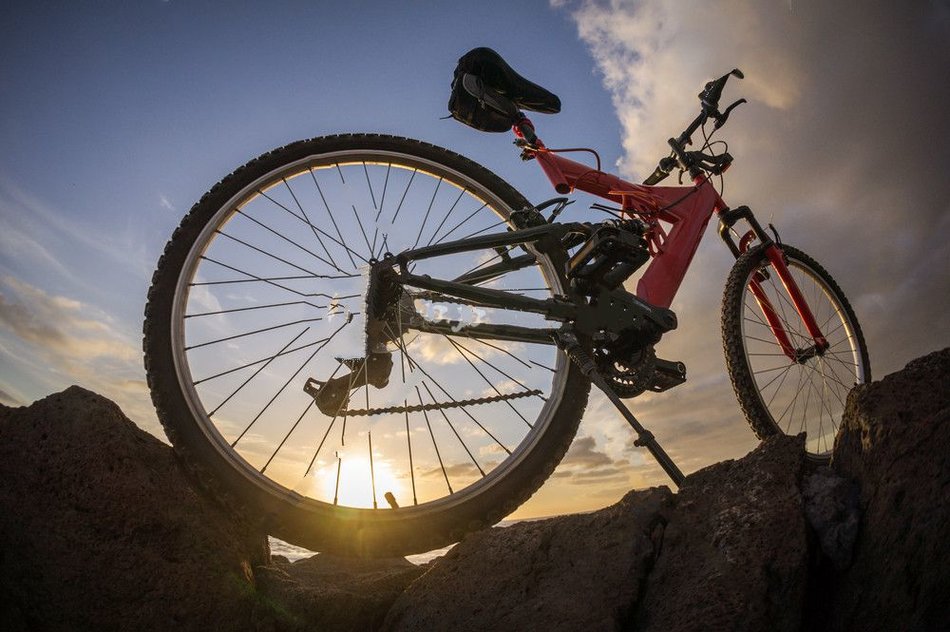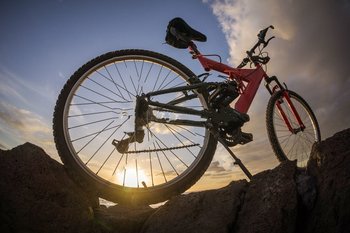
Nowadays, no. Most mountain bikes do not come with a kickstand when you first buy one. You usually need to ask the seller if they can add a kickstand to the bike you want to buy. You can also buy a kickstand separately yourself and install it on to your bicycle.
Why Don’t Mountain Bikes Have Kickstands
- Damage frame. High end mountain bikes are made with light frames. Having a kickstand clamped on or bolted on could damage the frame and throw it off balance. This can also cause it to be less stable and maneuverable.
- Added weight. Many mountain bikers are what are called ‘weight weenies’. This means they do not want to have any extra weight on their bicycle unless it is absolutely necessary. Why. So the overall weight of their bike is as light as possible so they can go as fast as possible.
- More dangerous if you crash. If you are riding on a trail and heaven forbid you crash, you may become impaled by your kickstand. There is no guarantee the kickstand will stay up and not go down during a crash.
- Bicycle may fall over. When you are riding off road the trail is not even. There are hills and turns. Also the ground may be soft in many areas so it is easy for your bicycle to fall over. The kickstand may sink into the ground and or wind may tip it over.
- Inconvenient to take on and off. When you are mountain biking you want your bike to be light. So if you still want a kickstand you can put one on when you want to park your bicycle. Then when you go off road you can remove it. But this can be a hassle.
- No need for it. Most off road riders are just fine laying down their bike on the ground or leaning it against a tree. If they need to rest or repair something on their bicycle, that is what they do.
- Fall off on the trail. Mountain biking is a rough activity. Riders go over roots, small and large rocks, off drops at high speeds. A kickstand can sometimes fall off after working its way loose because of the rough rides.
- Mountain bikes are durable. Mountain bicycles are made to be tough. It is not a big deal to lay down your bicycle on the ground or to lean it against the side of a tree.
- Lean your bicycle. You can easily lean your bike against a tree, a rock, a fence, even a thick bush. Just make sure the front wheel is straight.
- No stops. When you are out off road you are going and going on the trail. Up hills and down hills, over rocks and roots. Around curves and corners. Going over jumps and drop offs. You seldom stop, which means not much use for a kickstand.
- Your racing. Racers have the need for speed. So they have no need for a kickstand. They want their bikes to be as light as possible. I saw a race where a guy was trying kick his kickstand back in place after it fell down. The rider fell down while kicking his kickstand and caused other riders to crash.
- Damage bike with kickstand. If your bicycle is using a kickstand and it gets knocked over it could suffer damage to its derailleur, brake levers, chain and paint finish. Then after, if you tighten the loose bolts its sleeve can squeeze and damage the chainstays.
- Bicycle stands everywhere. There are many places that offer bicycle parking. Places such as schools, libraries, shopping malls, parks, mountain bike racing events.
Which Mountain Bikers Should Use a Kickstand
Beginners to mountain biking should use a kickstand. When you are riding off road your fitness level and skill level is not as high as a more experienced rider. Therefore you will probably need to take more breaks and stop more often.
Just make sure you are standing your bicycle on level ground so that it does not fall over. Also make sure your bicycle is standing on solid ground and not in muddy, wet, or soft ground. It may start to sink into the ground and then fall over.
Children and the elderly should use a kickstand. More than likely they are not racing, so they do not need their bike to be as light as possible. Plus they may also be using their bike on a paved road, so when it comes time to stop it is much easier to park their bike using a kickstand.
How To Safely Lay Down a Mountain Bike When You Have No Kickstand
The first thing you want to do is position your bike so the derailleur is facing away from you. You do not want to lay down your bike on to the derailleur, this could damage it.
Next place one hand on the bike seat and the other hand is on a handlebar while the bike is upright and horizontal to you.
After that, begin to walk backwards while holding onto the bike seat and handlebar. Let your bicycle lean toward you until you place it completely on the ground at your feet. As the bike leans toward you, you should bend yourself forward allowing the bike to be lowered.
If you lowered the bicycle on the other side you could damage the derailleur and the drivetrain. The bike chain might also pick up dirt, grass, or leaves.
7 Ways To Lean Your Mountain Bike Without a Kickstand
- Handlebar lean. This lean is good for beginners who have an inexpensive bike. You lean lean your bike against a wall using the left or right handlebar as the point of contact.
- Upside down. Turn your bicycle upside down and allow your bicycle to stand on the seat and the handlebars. This leaves the underside of the bicycle exposed. Plus if the ground is a rough surface you may scratch the seat and brake levers. This is also a beginner technique.
- Fence bar hook. This is more advanced. Just hook one of the handlebars over the railing of a fence preferably metal. Make sure the fence is high enough so the front wheel is suspended in the air after you hook it.
- Back wheel lean. Lean your bike against a wall, tree, or pole using the rear wheel as the only point of contact. Turn the front wheel toward the wall, tree, or pole so the weight goes toward what you are leaning against.
- Front rear combination. Lean your bike against a wall using the seat and a handlebar as the only point of contact touching the wall.
- Seat rest. Lean your bike using the bike’s seat as the only point of contact. Make sure the front wheel is straight to prevent it from rolling left or right.
- Bike to bike lean. If there is no wall, tree, or pole available, then find two bikes. Make sure they are standing securely. Then lean your bike against one of the bikes.
How To Choose the Best Kickstand
There are certain attributes a kickstand should have which make them better than others. Not all mountain bike kickstands will have all these characteristics but try to find as many of them as possible in one kickstand and buy that one.
- Easily adjust to any height and angle. If the kickstand is too short or too long for your bike, your bike will tip over.
- Built-in feet. These feet will help to keep the kickstand from slipping and increase stability.
- Double-leg. You may want your bicycle to stand straight.
- Rubber feet. Prevent the kickstand from slipping if the ground is wet.
- Light and sturdy. Keeps your bike as light as possible while maintaining durability.
- Won’t be in the way. You can pedal freely without hitting the kickstand.
- Easy to install. You don’t want to spend 2 hours adding a kickstand.
- Handles uneven ground. It has large enough kickstand feet to prevent easily being tipped over.
- Right length. Some kickstands are not adjustable. Make sure you have the right length for your bike size.
- Clamps with no sliding. Kickstand clamps on to chainstay securely without sliding up and down the chainstay which will cause damage.
- Universal mounting bracket. It is able to fit all mountain bikes.
- Rust proof screws. This prevents the screws from rusting which will cause the kickstand to loosen and eventually fall off.
What are Some Kickstand Alternatives For Mountain Bikes
So far I have found 2 alternatives to using a kickstand, one is called the Upstand and the other is called the Click-Stand.
The Upstand connects to the bike’s fast release which is near the rear axle. It collapses down into 2 pieces so you can fold it and store it in your pocket or any convenient place you wish. It is available in three sizes, for 20 inch, 26 inch, and 29 inch wheel bicycles.
The Click-Stand is longer than the Upstand because it connects to the top tube of the bicycle, underneath it. There is a U-shape at one end which supports the bike underneath the top tube.
On the other end is a bungee cord which you pull and then you fasten it in between the top tube of your bike and the U-shape of the Click-Stand. This causes the U-shape end of the Click-Stand to remain securely connected to the top tube of your bike.
Conclusion
You basically have three options. You can use a kickstand, you can not use a kickstand but use the ground or lean your bike, and finally you can use an alternative kickstand.
Related
30 best mountain bike storage ideas

